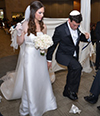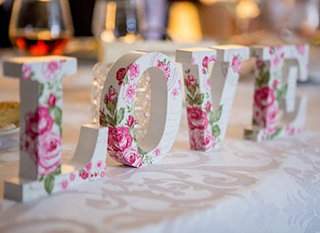Interesting Wedding Traditions from around the World
Whilst the celebration of a wedding is a universal tradition, there are a number of cultures and religions have their own way of marking the celebration. In some cases it may not be the best man’s speech you need to be most concerned about. Here are just a few of the more interesting wedding traditions from around the world.
Jumping the broom
 “Jumping the broom” is an informal marriage used in Romany marriages before the idea of a civil marriage and as an alternative to a church marriage. It originally comes from ancient military weddings when the bride and groom jumped hand-in-hand over a sword (the “broomstick” comes from a mistaken translation) after which they were considered man and wife.
“Jumping the broom” is an informal marriage used in Romany marriages before the idea of a civil marriage and as an alternative to a church marriage. It originally comes from ancient military weddings when the bride and groom jumped hand-in-hand over a sword (the “broomstick” comes from a mistaken translation) after which they were considered man and wife.
Sing a Poem during Sawer
 The Sawer ceremony begins by a poem that has a spiritual value being sung to educate the bride and groom. Then, the bride and groom will receive a bag consisting of rice, loose change, candy, and turmeric. The rice is for the bride and represents prosperity and prayer. Coins symbolise the hope that can be achieved by the bride by sharing with the poor. While confectionery symbolises the meaning of sweet life and turmeric which is a symbol of glory. Sawer has the meaning of conveying the advice of both bride and groom parents. This ceremony also symbolises the endless love and affection of both sets of parents.
The Sawer ceremony begins by a poem that has a spiritual value being sung to educate the bride and groom. Then, the bride and groom will receive a bag consisting of rice, loose change, candy, and turmeric. The rice is for the bride and represents prosperity and prayer. Coins symbolise the hope that can be achieved by the bride by sharing with the poor. While confectionery symbolises the meaning of sweet life and turmeric which is a symbol of glory. Sawer has the meaning of conveying the advice of both bride and groom parents. This ceremony also symbolises the endless love and affection of both sets of parents.
Stealing shoes
 The ‘Joota Chori’ rasam literally means ‘hiding shoes’. The bride and the groom are initially asked to remove their shoes before stepping inside the mandap’ where the wedding ceremony takes place. During this time, the bride’s sisters steal the groom’s shoes as a prank and promise to give the shoes back only if they get a handsome fee in return. The origin of this centuries old tradition is unknown. Besides getting money, the bride’s sister’s get ‘Kalecharis, which are rings made out of gold, while the bride’s cousins get rings made out of silver. Much singing, dancing, and merrymaking takes place during Joota Chori which adds to the overall charm and appeal of this age-old tradition.
The ‘Joota Chori’ rasam literally means ‘hiding shoes’. The bride and the groom are initially asked to remove their shoes before stepping inside the mandap’ where the wedding ceremony takes place. During this time, the bride’s sisters steal the groom’s shoes as a prank and promise to give the shoes back only if they get a handsome fee in return. The origin of this centuries old tradition is unknown. Besides getting money, the bride’s sister’s get ‘Kalecharis, which are rings made out of gold, while the bride’s cousins get rings made out of silver. Much singing, dancing, and merrymaking takes place during Joota Chori which adds to the overall charm and appeal of this age-old tradition.
Kiss the groom
 This innovative Danish tradition ensures everyone is feeling the love on the big day. At the reception if the bride leaves the table, every female member of the bridal party will rush to kiss the groom. The bride isn’t left out either – the male members of the party kiss the bride when the groom nips to the bar or the loo.
This innovative Danish tradition ensures everyone is feeling the love on the big day. At the reception if the bride leaves the table, every female member of the bridal party will rush to kiss the groom. The bride isn’t left out either – the male members of the party kiss the bride when the groom nips to the bar or the loo.
Blackening the bride
 The blackening of the bride is a Scottish tradition that is an extreme take on the stag and hen celebrations. The bride, or sometimes the bride and groom are made as dirty as possible using anything from flour, treacle, custard and soot before they are coated in feathers. The origins of this tradition are unclear, but the idea is to confer luck on the couple as they start their life together.
The blackening of the bride is a Scottish tradition that is an extreme take on the stag and hen celebrations. The bride, or sometimes the bride and groom are made as dirty as possible using anything from flour, treacle, custard and soot before they are coated in feathers. The origins of this tradition are unclear, but the idea is to confer luck on the couple as they start their life together.
Hindu wedding exchange
 The Hindu equivalent of a wedding ring is called a Thaali, which is a thread coated with turmeric. For those that can afford it, the bride wears a gold chain around her neck, with pendants or beads with different designs. This tying of the ‘thaali’ by the groom is the most important ritual in every wedding ceremony. Traditionally, the groom will be given a toe ring, called ‘metti’ which he wears on his second toe. The significance is cultural. Men traditionally were to be brave and bold and keep their eyes looking straight, while women should be modest and should always look down. As men who look straight ahead, it is easier to spot the necklace and immediately know that the women is married and women will easily spot the ring in the man’s toe and know he’s married.
The Hindu equivalent of a wedding ring is called a Thaali, which is a thread coated with turmeric. For those that can afford it, the bride wears a gold chain around her neck, with pendants or beads with different designs. This tying of the ‘thaali’ by the groom is the most important ritual in every wedding ceremony. Traditionally, the groom will be given a toe ring, called ‘metti’ which he wears on his second toe. The significance is cultural. Men traditionally were to be brave and bold and keep their eyes looking straight, while women should be modest and should always look down. As men who look straight ahead, it is easier to spot the necklace and immediately know that the women is married and women will easily spot the ring in the man’s toe and know he’s married.
Jewish “Breaking of the Glass” ceremony
 The Breaking of the Glass ceremony in a Jewish wedding symbolises the destruction of the Temple in Jerusalem. The broken goblet is a reminder of sadness even in during the most joyous of occasions. It is also said to symbolise the permanence of marriage and the care required to maintain this bond as they settle into their life together. After the groom breaks the glass, the Hebrew for Good Luck and Congratulations: “Mazel Tov,” is shouted.
The Breaking of the Glass ceremony in a Jewish wedding symbolises the destruction of the Temple in Jerusalem. The broken goblet is a reminder of sadness even in during the most joyous of occasions. It is also said to symbolise the permanence of marriage and the care required to maintain this bond as they settle into their life together. After the groom breaks the glass, the Hebrew for Good Luck and Congratulations: “Mazel Tov,” is shouted.
Norwegian fiddlers
 At a traditional Norwegian Wedding Procession, two fiddle players lead the wedding procession, with the bride and groom close behind. Everyone has to make sure they would be in the right place in the procession. After the bride and groom are their parents, bridesmaids, ring bearer, flower girls and the eager guests came last. In some places the men ride horses in front of the women. The bride would always have the best horse – usually a light-coloured steed.
At a traditional Norwegian Wedding Procession, two fiddle players lead the wedding procession, with the bride and groom close behind. Everyone has to make sure they would be in the right place in the procession. After the bride and groom are their parents, bridesmaids, ring bearer, flower girls and the eager guests came last. In some places the men ride horses in front of the women. The bride would always have the best horse – usually a light-coloured steed.



